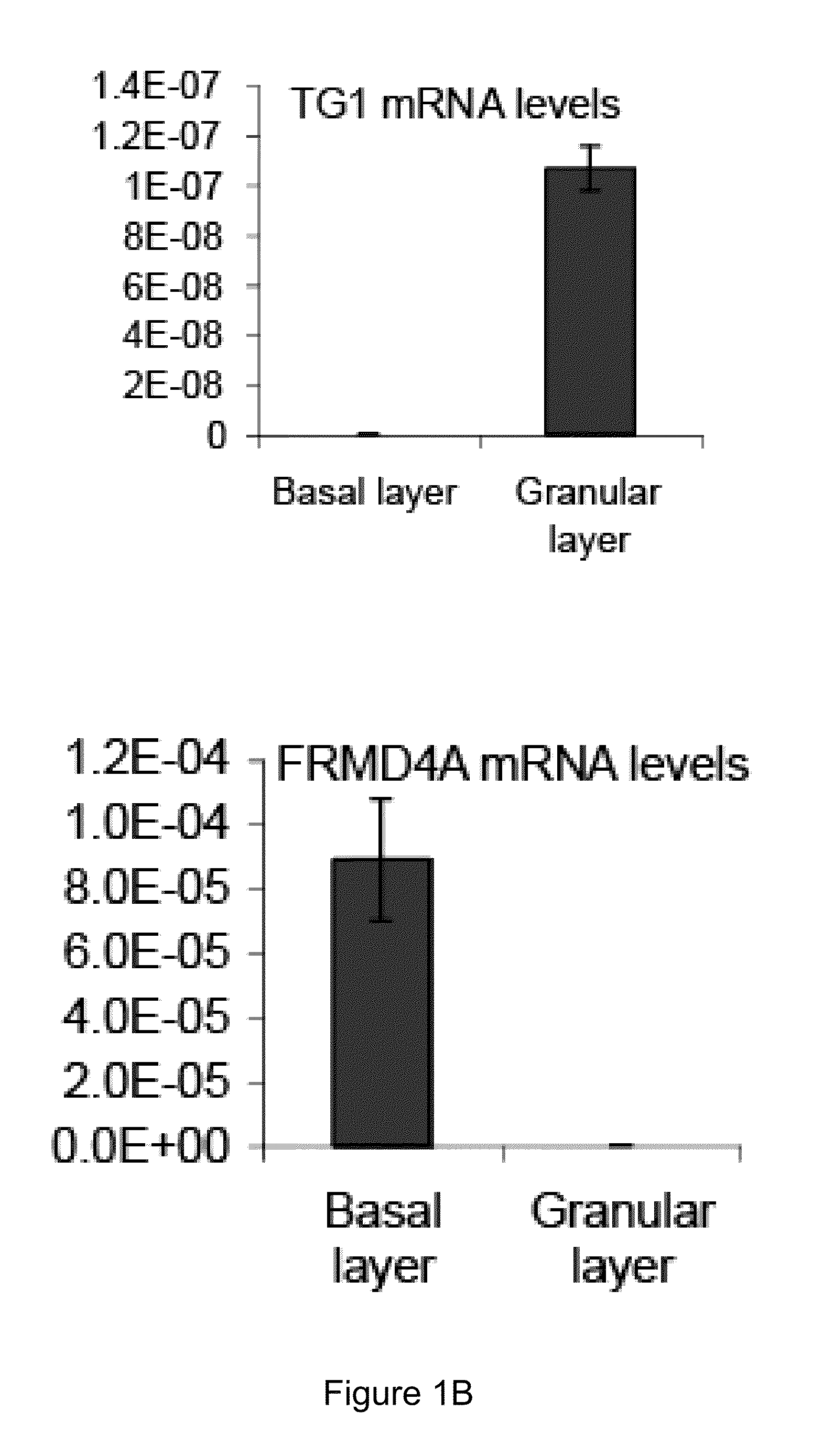Frmd4a antagonists and their uses
a technology of frmd4a and antagonists, which is applied in the field of frmd4a antagonists, can solve the problems of oral scc survival rate that has not improved for 30 years, lesions that recur and spread to other body sites, etc., and achieves the effects of reducing the growth of scc cells, reducing the proliferation of scc cells, and increasing animal survival
- Summary
- Abstract
- Description
- Claims
- Application Information
AI Technical Summary
Benefits of technology
Problems solved by technology
Method used
Image
Examples
example 1
Antagonists of FRMD4a In Vitro and In Vivo
Materials and Methods
Human Tissue Specimens
[0128]Appropriate informed consent was obtained from patients diagnosed with oral SCC, prior to operation at Addenbrooke's Hospital. Small biopsy specimens were removed from freshly resected oral SCCs by a Consultant Pathologist, before fixation. Normal specimens of skin were obtained with informed consent from operations to remove excess skin. Specimens were processed as described below.
In-Situ Hybridisation
[0129]Probes were generated to FRMD4A and beta-actin as a control, then In situ hybridization was performed as previously described on sections of paraffin-fixed human foreskin.
Antibodies
[0130]Six polyclonal antibodies to FRMD4A were produced and purified (SGO-1 to -6). Polyclonal antibodies were generated using the following peptides from the FRMD4A protein as antigen. SGO-1 and SGO-2 were raised against a peptide corresponding to amino acids 63-83 (SEQ ID NO: 3: IAFTDETGHLNWLQLDRRVLE). SGO-3 a...
example 2
Monoclonal Anti-FRMD4A Antibodies
[0180]Monoclonal antibodies were raised against a peptide derived from human FRMD4A (DRRVLEHDFPKKSGPVVLYFC) SEQ ID NO: 6, which is residues 78 to 98 of the sequence set forth in SEQ ID NO: 1, using the HuCAL technology (AbD Serotec).
[0181]Western blot analysis was used to confirm monoclonal antibody binding to FRMD4A (see FIG. 10). SCC13 cells were treated with siRNA targeting human FRMD4A (A7) or scramble control siRNA (SCR) and levels of FRMD4A determined using 5 distinct monoclonal antibodies, (GOLDIE-1, GOLDIE-2, GOLDIE-3, GOLDIE-4 and GOLDIE-5). Loss of staining intensity was observed in the FRMD4A siRNA treated cells, demonstrating that the monoclonal antibodies bind to human FRMD4A. GAPDH was used to confirm equal protein loading.
example 3
FRMD4A Antibody Efficacy Requires the Presence of FRMD4A
[0182]SCC25 and SCC13 cells were treated with either scramble control siRNA (Scr) or FRMD4A siRNA (A7) (see FIGS. 11A and 11B). Loss of FRMD4A protein expression was observed in the A7 treated cells. Treatment of the Scr cells with SGO-1 FRMD4A antibody reduced cell confluence. In contrast, in the absence of FRMD4A, A7 treated cells showed no reduction in confluence when treated with SGO-1 antibody. Therefore, antibody efficacy requires the presence of FRMD4A, suggesting that the antibody mediates its effects through binding to FRMD4A. This indicates that the anti-cancer activity of the FRMD4A antibody is the result of the antibody binding to FRMD4A.
SequencesNCBI Accession No. NP_060497; GI: 116063562 (Human FRMD4A protein sequence)SEQ ID NO: 1:1mavqlvpdsa lgllmmtegr rcqvhllddr klellvqpkl lakelldlva shfnlkekey61fgiaftdetg hlnwlqldrr vlehdfpkks gpvvlyfcvr fyiesisylk dnatielffl121naksciykel idvdsevvfe lasyilqeak gdfssnevvr sdlkkl...
PUM
| Property | Measurement | Unit |
|---|---|---|
| dissociation constant | aaaaa | aaaaa |
| dissociation constant | aaaaa | aaaaa |
| dissociation constant | aaaaa | aaaaa |
Abstract
Description
Claims
Application Information
 Login to View More
Login to View More - R&D
- Intellectual Property
- Life Sciences
- Materials
- Tech Scout
- Unparalleled Data Quality
- Higher Quality Content
- 60% Fewer Hallucinations
Browse by: Latest US Patents, China's latest patents, Technical Efficacy Thesaurus, Application Domain, Technology Topic, Popular Technical Reports.
© 2025 PatSnap. All rights reserved.Legal|Privacy policy|Modern Slavery Act Transparency Statement|Sitemap|About US| Contact US: help@patsnap.com



